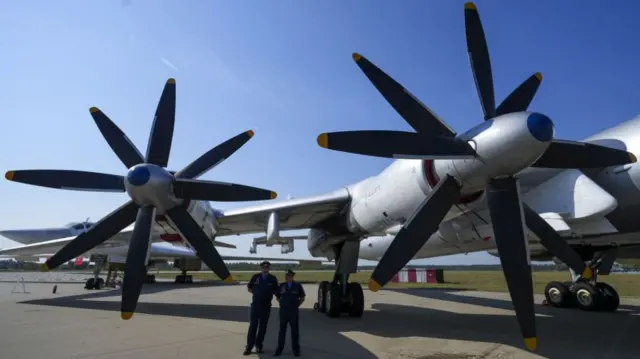
Russia’s major military assets shown to be vulnerablepublished at 15:29 British Summer Time 1 June
Chris Partridge
BBC News weapons analyst
These attacks will have dealt a significant blow to Russia’s
aerial cruise missile strike capability.
Tu-95 bombers, which are among the type of aircraft that have been
destroyed, are said to have launched a large-scale Kh-101 missile attack on
Ukraine earlier this year. They have been used extensively since the full-scale
invasion of February 2022 and so are a vital target for the Ukrainian military.
Each bomber can carry eight guided cruise missiles and each
missile itself carries a 400kg (882lb) warhead. The weapons’ range is thousands of
kilometres, which allows such strategic aircraft to deploy well inside the
relative safety of Russian airspace.
 Image source, Getty Images
Image source, Getty ImagesA file photo shows a Tu-95 strategic bomber in Moscow – this type of aircraft is among those hit
But just as significant is the reported loss of an A-50, the Russian equivalent of AWACS, whose role is to detect enemy aircraft and missiles, and feed those targets to Russian fighter jets. It performs a management role for aerial assets, by giving a big picture view and direction.
As for the strikes themselves, the use of drones in at least one, so close to the targets means that traditional Russian self-defence systems such as S-300 / S-400 long range SAMs, and even their shorter-range counterparts, Pantsir SA-22s, are ineffective. It also means that there was little warning that such an attack was coming to get aircraft to the relative safety of hardened shelters.
It may be that some of the Russian aircraft were not completely destroyed, and they can be repaired, but that still takes them – at the very least – out of the fight for a long time. More worrying for Moscow, it again points to the vulnerability of major military assets well inside Russian Federation territory itself.





